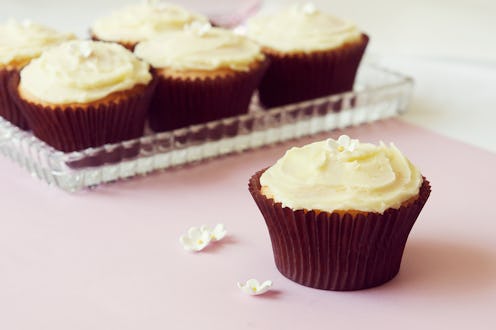Books
7 Easy Ways To Go Gluten-Free

Some people are forced to go on a gluten-free diet because of a diagnosed medical condition like celiac disease, while others suffer from gluten sensitivity. There's also a growing group of individuals who are avoiding gluten because they feel better when they're not constantly nomming on pasta and bread. Regardless of the motivation, once you decide to go G-free, actually changing your diet can be intimidating, because what is gluten, exactly? And why is it so bad?
These are questions April Peveteaux had to answer when she was diagnosed with celiac disease, an autoimmune disorder that caused a whole host of health issues, least of all spending a lot of time in the bathroom. She started a blog Gluten Is My Bitch to figure out how to eliminate this mysterious protein. Years later, she's still "educating about gluten-free living and providing you with delicious recipes to make you happy no matter how sad you are about pizza."
Going gluten-free is "a dramatic shift in your day-to-day life as well as your long-term goals," Peveteaux writes in her new book The Gluten-Free Cheat Sheet: Go G-Free in 30 Days or Less. "But if you can replace that gluten craving with delicious food that will not kill you, well, that's awesome, right?" Making the change requires some guidance, and Peveteaux is a perfect guide: "I've gone through the various stages of gluten grief and come out on the other side with a heck of a lot of fantastic ideas and recipes to make me forget about my gluten-free woes."
The Gluten-Free Cheat Sheet: Go G-Free in 30 Days or Less by April Peveteaux, $13, Amazon
Whatever your motivation for going gluten-free, here are nine tips from The Gluten-Free Cheat Sheet to help you make the transition as painless and easy as possible:
Create a Gluten-Free Kitchen
If you're committed to going gluten-free, start by creating a gluten-free kitchen. The easiest way to ensure you won't eat any gluten is to make sure there's none around. "This is the area where you do have total control," explains Peveteaux, "and you should keep your kitchen 100 percent gluten-free." If you do have to bring in gluten, "treat it as the invader that it is: Quarantine that gluten. Have a designated pan for cooking any gluten, and never, ever use it to prepare your own foods."
Know Where Gluten Is Hiding
To make sure you have a perfectly gluten-free kitchen, and to protect yourself when you eat out, you need to know what products have gluten in them and what foodstuffs are safe. And while certain foods scream "gluten," like loaves of bread or boxes of spaghetti, gluten also lurks in places you wouldn't expect, like soy sauce or any mustard made with beer. Peveteaux has compiled a list of these secret gluten sources in her book, and you should commit it to memory.
Find Your Favorite Gluten-Free Cheats
Yes, you have to make some sacrifices when you go gluten-free, but with the increased interest in gluten-free options comes more gluten-free alternatives. You might have thought you'd never be able to drink beer again (and you shouldn't just pop open a craft brew, for the record), but there's now gluten-free beer. There's also gluten-free pasta, gluten-free pancake and waffle mixes, even gluten-free baguettes. But before you get too excited about all these gluten-free cheats, Peveteaux reminds us, "Don't forget to read the fine print if you don't want to wind up on the pot."
Avoid Packaged and Processed Foods
You know what foods never have gluten? Fresh fruits and vegetables. If you find that you, like Peveteaux, sometimes get "frustrated trying to read too many packages wrapped around my gluten-free foodstuffs," head to the outer aisles of the grocery store. Going gluten-free will be much easier if you "make it your goal to eat mostly whole foods and relegate anything in a package to a sometimes food," advises Peveteaux.
Eat Out More
Going gluten-free doesn't mean becoming a hermit who never leaves the house or relying solely on home-cooked meals. You should never feel bashful about asking for gluten-free options on a restaurant's menu because, "Everyone and her Kardashian are avoiding gluten, so most restaurants will totally know what you're talking about." Feel free to frequent cuisines that traditionally don't use much gluten including traditional Mexican food, as long as you avoid flour tortillas; sushi, as long as the rice isn't doused in wheat vinegar or soy sauce; and Ethiopian food.
Always Carry Gluten-Free Snacks
As Peveteaux writes, "Whether it's a friend's birthday or a family vacation, you will wind up in an unsafe environment at some point." But instead of curling up in a ball and feeling bad about yourself, pull out that pack of gluten-free snacks you always carry on your person, and eat those until you can have a full meal. Some snacks that Peveteaux suggests include mixed nuts, cheese and gluten-free cracker, and fresh berries.
Be Kind to Yourself
No matter how many questions you ask a waiter, or how many times you check a label, sometimes gluten slips into your diet. It can also be exhausting and anxiety-inducing to constantly be on guard about what you can and cannot eat. "If/when you do accidentally ingest gluten and find yourself sick again, know that you will come out of it again. Don't let one slipup become an excuse to binge on more gluten-filled foods," writes Peveteaux. Staying positive is important, especially when it's your health and wellbeing on the line. Yes, it's a challenge to stay gluten-free, but if it makes you feel better, it will always be worth the struggle.
Images: Amazon; balancelegance, brewdogofficial, peveteaux, loneeidseth/Instagram; Kimberley Craig/flickr